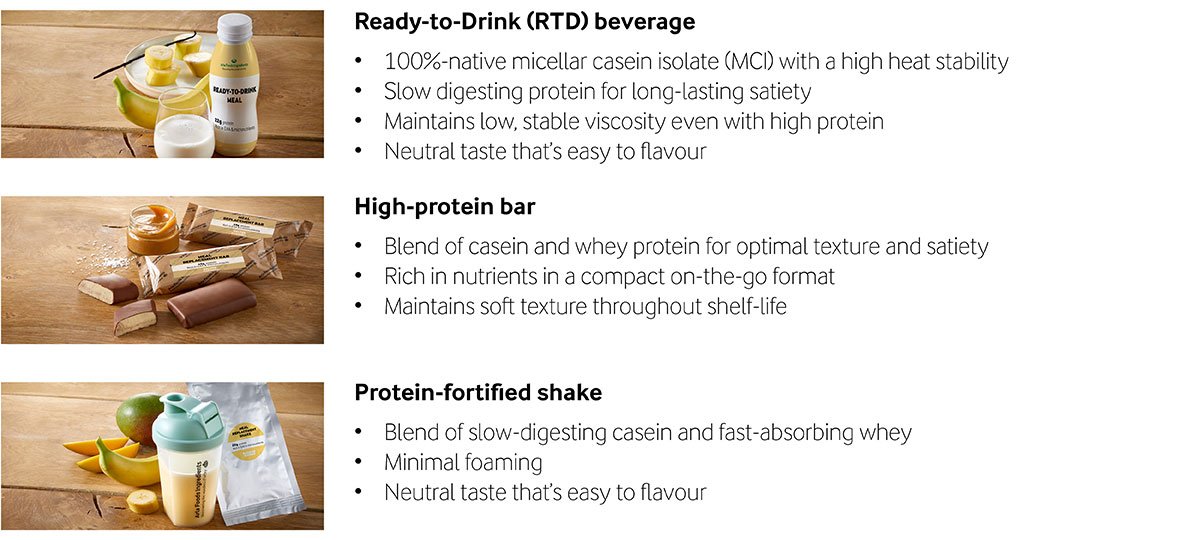Balanced meal replacement solutions
Introducing three high-protein meal replacement solutions to support active lifestyles and healthier weight management.
Easy living - in healthier ways
Today’s weight management market has moved from crash-diet weight loss programs to a more holistic, health-oriented approach that focuses on gradual lifestyle changes. It’s a trend that puts meal replacements, consumed in the form of protein bars, powder shakes or ready-to-drink (RTD) beverages, in the innovation spotlight.
A thriving opportunity
In fact, one or more replacement meals a day has become a lifestyle thing - and consumers are turning them into a mainstream favourite and 1 in 4 consumers say that they consume meal replacement products at least once a week with a steady growth rate of 7% in the last 10 years1.
It’s a dynamic market showing growth potential, with the global market for weight management amounting to USD 88bn in 2020. The US and Europe currently hold the largest market values, however, MENA and Asia are in top 3 fastest growing markets2.
The most popular products on the market today emphasise good taste, natural ingredients, low sugar and high protein content3. And they’re backed by evidence from clinical studies4,5,6,7 suggesting that, for busy consumers, a diet including meal replacement products may support weight maintenance or loss.
Flexible choices to match consumer lifestyles
Arla Foods Ingredients has developed three convenient protein solutions that all live up to meal replacement requirements, while offering food manufacturers maximum flexibility.
Now consumers can get all the nutrition they need in great-tasting products: carbohydrates, protein, fibre and fats, and rich in essential vitamins and minerals - without spending a moment to prepare the meal. And they can get it in the convenient formats their busy lifestyles demand.
Meal replacement supported by science: On-demand webinar
You can view our webinar on how to extend your portfolio with convenient nutrition high-quality protein solutions for meal replacements - supported by science and matching consumer lifestyles. Click here to go to on-demand webinar (pre-registration required)

High-quality protein performers
Spurred on by the global emergence of natural ingredient preferences, whey protein and casein are among the most popular meal replacement protein sources8. Both are highly digestible proteins, rich in essential amino acids, with clinically proven protein synthesis9. Whey protein is more rapidly absorbed into the blood stream, while casein, which takes longer to digest, keeps consumers satiated for longer. Mixing the two in bars or shakes can make an optimal recipe for effective, longer-lasting satiety.
Possible on-pack, on-trend claims
Food marketers won’t miss the opportunity, too, to use these new solutions to support compelling on-pack claims10. “High protein” is supported in the range, and in EU countries and the US, encouraging one meal replacement per day enables manufacturers to promote the benefit of weight maintenance following weight loss, while two replacements per day are required to support claims for weight reduction11.
References
- HealthFocus® International 2020 International Trend Study
- Euromonitor International, 2020
- New Nutrition Business, 2020
- Ard et al. Obesity. 2019 Jan;27(1):22-29. Effectiveness of a Total Meal Replacement Program (OPTIFAST Program) on Weight Loss: Results from the OPTIWIN Study
- Ard et al. Obesity. 2019 Jan;27(1):22-29. Effectiveness of a Total Meal Replacement Program (OPTIFAST Program) on Weight Loss: Results from the OPTIWIN Study
- Leader et al. Obesity. 2013 Feb;21(2):251-3. How best to use partial meal replacement in managing overweight or obese patients with poorly controlled type 2 diabetes
- König et al. Nutrition. Nov-Dec 2014;30(11-12):1306-9. A meal replacement regimen improves blood glucose levels in prediabetic healthy individuals with impaired fasting glucose
- Innova Database, 2021
- Dangin, M., Guillet, C., Garcia-Rodenas, C., Gachon, P., Bouteloup-Demange, C., Reiffers-Magnani, K., Fauquant, J., Ballèvre, O., & Beaufrère, B. (2003). The rate of protein digestion affects protein gain differently during aging in humans. The Journal of Physiology, 549(Pt 2), 635–644.
- Commission Directive 96/8/EC, 2007/29/EC
- International CODEX Standard 181-1991. Variations occur in individual country implementation of the CODEX Standard.





